From the dramatic
reaches of the Clyde Valley to the pulsating city streets of Glasgow and the glorious
rural landscapes of Renfrewshire and Inverclyde, Greater Glasgow and Clyde Valley is a
destination with "diversity" as its calling card.
Over the centuries, the famous River Clyde has
breathed life and inspiration into the area. From its source in the rolling Lanarkshire
hills to its spectacular passage to the sea, the river's winding route echoes a heritage
and culture that is every bit as valued and distinct as the city, towns and villages which
emanate from its banks.
At its heart is Glasgow, one of the world's
truly great cities and a dynamic centre of culture. The city prospered through its ability
to trade in tobacco, sugar and cotton with the American colonies. When it embraced the
industrial revolution, its reputation for quality shipbuilding
on the Clyde spread throughout the world. Glasgow earned its reputation as "Second
City of the British Empire".
Glasgow,
Scotland’s largest city, has a history stretching back to earliest times. Stone Age
canoes unearthed along the banks of the River Clyde point to the existence of fishing
communities. Celtic druids were among the
first identifiable religious tribes to have lived in the area. They probably traded with
the Romans who, around 80AD, would have had a trading post in Cathures, the earlier name
for Glasgow.
Beyond 380AD, when
the great Christian missionary St Ninian passed
through Cathures, consecrating a burial ground, little is known until the arrival
of St Kentigern in the 6th century. St Kentigern settled in Glasgow (or Glas
cu, most generally interpreted as "dear green place") in 543AD following
exile from Culross, where his monastic brothers had grown jealous of his miracle powers.
Today, Glasgow is one of the UK’s most visited cities.
The city that hosted the highly popular Glasgow Garden
Festival in 1988, was European City of Culture in 1990, and mounted the spectacular
Glasgow Festival of Visual Arts in 1996, welcomes over 2 million tourists from all over
the world each year who are drawn by its wealth of cultural attractions and activities.
A CITY OF HISTORY
Around Glasgow, ancient buildings and historical streets
and monuments relate a fascinating and influential past:
- Glasgow Cathedral marks the burial spot of St Mungo, the
city’s founder and patron saint
- While visiting Glasgow’s oldest house, the Provand’s
Lordship, Mary Queen of Scots is said to have plotted the infamous murder of Darnley
- On Glasgow Green - the city’s oldest public park - is the
stone on which James Watt is said to have sat, pondering his revolutionary inventions
which were to spark off the Industrial Revolution
- The Merchant City, where Glasgow’s rich merchant traders built
their mansions, banks and warehouses, has a charm and character of its own
- The People’s
Palace is a veritable treasure trove of Glasgow memorabilia, relating the story of
the city’s social and political past
A CITY OF ARCHITECTURE
Glasgow’s architecture is among the finest in Europe.
In 1999, the city has been designated UK City of Architecture and Design:
- Glasgow’s elegant streets are lined with some of the
finest and most beautifully preserved Victorian buildings
- The magnificent City Chambers,
Glasgow’s municipal headquarters in George Square,
stands as a proud statement to the city’s proud position during the 19th
century as "Second City of the Empire"
- Around the city are unique examples of Glasgow’s most
renowned architect and designer, Charles Rennie Mackintosh (including the famous
Glasgow School of Art),
and of the equally gifted Alexander "Greek" Thomson
- A full-scale programme of design projects and activities are
planned throughout Glasgow’s celebrations in 1999 as UK City of Architecture and
Design
A CITY OF MUSEUMS AND GALLERIES
Glasgow has over 20 wonderful museums and galleries, each
with its own individual collection and events programme, and all with free admission. They
include:
- The world famous Burrell
Collection, a purpose-built gallery opened in 1984 to house the unorthodox and
eclectic collection of artefacts gifted to Glasgow by Sir William Burrell
- The magnificent Glasgow Art Gallery and Museum in
Kelvingrove, which houses the city’s principal collection of paintings, and is the
Scotland’s most frequently visited free attraction
- The Transport Museum, with its ever popular
collection of Glasgow Trams, locomotives, an exact reconstruction of a 1930’s Glasgow
street, and the city’s new Museum of Football
- St Mungo’s Museum of Religious Life and Art, the
UK’s only museum celebrating the world’s many religions
- Glasgow Gallery of Modern Art, a brand new gallery set in the
refurbished Stirling’s Library, and housing the city’s principal modern art
collection
- Scotland Street School, a former Charles Rennie Mackintosh
School preserved as the city’s Museum of Education
CITY OF ARTS AND ENTERTAINMENT
The city that hosted the Great Exhibitions of 1888 and
1901, and was designated European City of Culture 1990 has a full and exciting range of
entertainment venues and activities:
- Glasgow is home to Scotland’s principal performing arts
organisations: Scottish Opera, Scottish Ballet, the Royal Scottish National Orchestra,
the BBC Scottish Symphony Orchestra, the National Youth Orchestra of Scotland,
the Citizen’s Theatre, and many more
- A wide range of excellent concert and entertainment venues
includes: the Glasgow Royal Concert Hall, the Theatre Royal, the City
Hall, the King’s Theatre, the Royal Scottish Academy of Music and Drama,
and the Scottish Exhibition and Conference Centre
- Glasgow’s diary of annual festivals and events
includes: the Glasgow International Jazz Festival (July), the RSNO Proms
(June), the Ten Day Weekend, the World Pipe Band Championships (August), and
the Christmas Shopping Festival Shine On Glasgow.
CITY OF PARKS AND GARDENS
The name Glasgow means "dear green place",
recognising the fact that Glasgow has over 70 parks and open spaces, more than any other
city its size. Many of them contain some of the city’s main galleries and
attractions, facilities for recreational activities, and many fine examples of Victorian
sculpture. Among their many features are:
- The exotic Victorian Kibble Palace in Botanic Gardens and
the grand Winter Gardens on Glasgow Green
- Victoria Park’s Fossil Grove, a fascinating display of
fossilised tree trunks more than 300 million years old
- The newly completed House for an Art Lover in Bellahouston
Park, designed by Charles Rennie Mackintosh almost a century ago, and recently built using
his original drawings
- The International Rose Garden in Tollcross Park, venue for
the city’s annual International Rose Trials
- Highland cattle and Clydesdale horses in Pollok Country Park
and Glasgow Green, and a Riding School in Linn Park
- Some of the most spectacular views of the city from
Queen’s Park
CITY OF SPORT
Sport is an integral part of Glasgow’s culture, reflected in the city’s
designation as a UK National City of Sport 1996-99. Among its state-of-the-art facilities
are:
- Three world class football stadia: the new National
Stadium at Hampden Park; Ibrox Stadium, home of Rangers Football Club, and
Celtic Football Team’s newly refurbished Celtic Park stadium
- The Kelvin Hall sports arena, the venue for many
international sporting events and competitions
- A full range of modern swimming pools and sports centres
CITY OF RETAIL AND SHOPPING
Glasgow has the largest retail sector out with London.
Residents and visitors from around the UK and overseas are drawn to the city’s
expanding shopping outlets, including:
- Shopping malls like the chic and trendy Princes Square,
the enormous St Enoch Centre, Sauchiehall Street Centre, Parkhead Forge,
the historical Argyle Arcade, and the forthcoming new Buchanan Galleries
- The main pedestrianised shopping thoroughfares of Sauchiehall
Street, Buchanan Street and Argyle Street.
- The unique and colourful Barras weekend street market
- The smaller, characterful outlets of the city’s
bohemian West End
- A wide range of top class cafés, restaurants, pubs and wine
bars
- City Centre Representatives to help shoppers and visitors
around the city, and a comprehensive City Watch close-circuit TV scheme keeping a watchful
eye on the streets.
CITY OF LEARNING
Since the city’s first university was established in
1451, Glasgow has been hailed as a powerful seat of learning. Lord Kelvin, Adam Smith and
James Watt are just some of history’s great thinkers associated with the city’s
academic past. Today’s educational establishments include:
- The
University of Glasgow
- Strathclyde University
- Glasgow Caledonian University
- Royal Scottish Academy of Music
- Glasgow
School of Art
- College of Commerce
- College of Building and Printing
- College of Food Technology
- Glasgow Hotel School (Strathclyde University)
CITY OF INFORMATION
Glasgow is the headquarters for Scotland’s principal
media organisations:
- Its main newspapers include The Herald, Evening Times,
Daily Record/Sunday Mail,
Scottish Mirror, Scottish Daily Express, Scottish Daily Mail, Sunday Times Scotland, and
the The Sunday Post
- Broadcast media includes the headquarters of BBC Scotland, Scottish
Television, and in nearby Clydebank, Radio Clyde, the independent radio station covering the Greater
Glasgow area
- Glasgow Film Office was recently established to
promote the city to film location managers around the world
Clyde Valley
A short distance up river, the rich seam of
fascinating attractions in the Clyde Valley reflecs the area's industrial and social
heritage. None more vividly than New Lanark World Heritage Village - Robert Owen's 19th
century revolutionary "new town" - tastefully preserved in its spectacular
riverside setting near the Falls of Clyde. Even in small conservation towns like Biggar, you'll
be amazed by the wealth and quality of unique places to visit.
To the west lies Renfrewshire and the historic
abbey of Paisley, the town whose weaving tradition developed the world famous Paisley
Pattern. And prepare to draw breath as you approach the dramatic scenery of Inverclyde,
with its panoramic views across the broader stretches of the Clyde Estuary to the Argyll
hills. The area prides itself in a maritime tradition poignantly celebrated in Greenock's
Custom House and McLean Museum.
Whatever the time of year, whatever your
interests, Greater Glasgow and Clyde Valley has something for everyone. Charles Dickens
said of his visit in 1847, "I have never been more heartily received anywhere, or
enjoyed myself more completely".
|
 
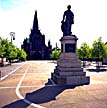
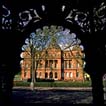
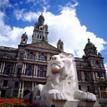

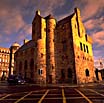
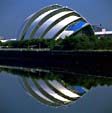

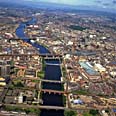
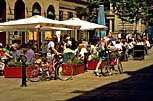
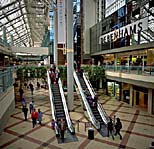
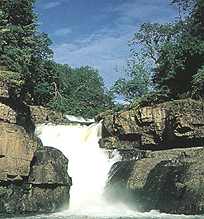
|

